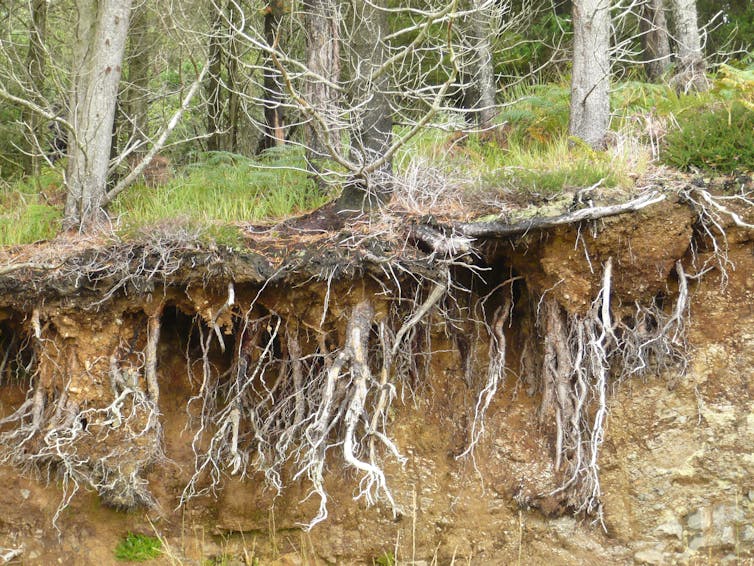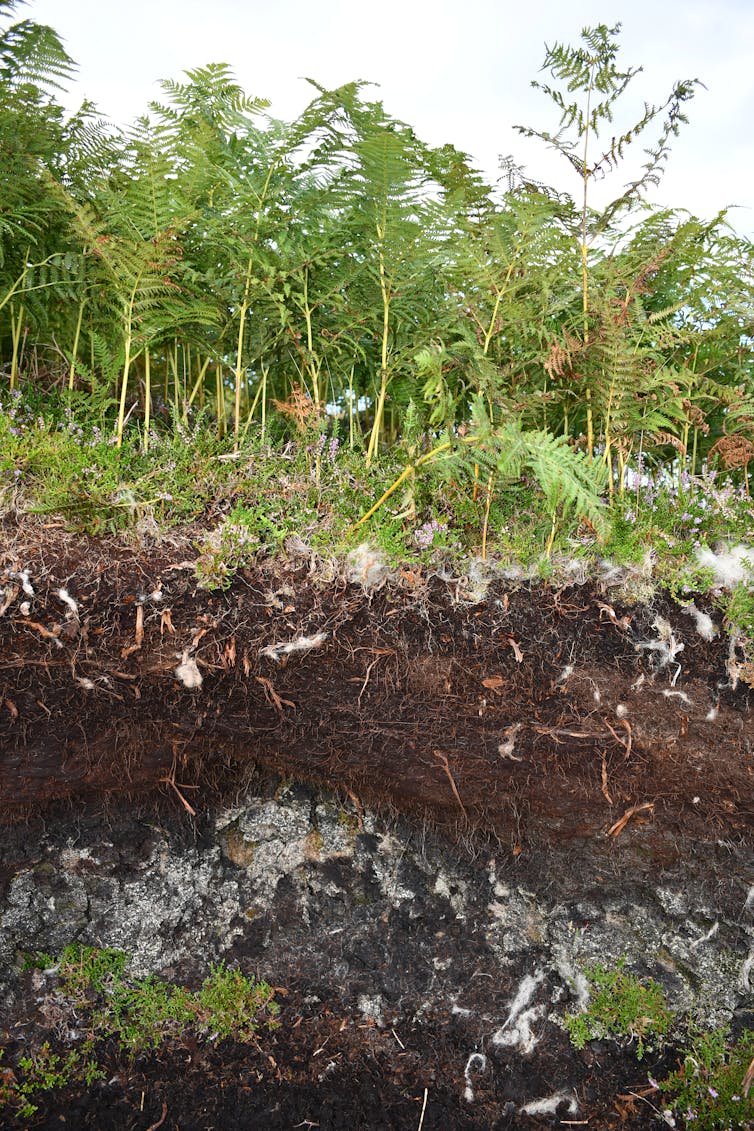For the first 4 billion years of Earth’s existence, its continents were dusty, barren and rocky landscapes similar to the surface of Mars. But, around 500 million years ago, this all changed.
You can listen to more articles from The Conversation, narrated by Noa, here.
Land plants began to evolve from their freshwater algal ancestors and gradually covered the planet’s rocky surface. Originally just a few centimetres tall, the first land plants quickly evolved into more complex forms. By 385 million years ago, extensive forests covered the planet’s surface.
This new plant diversity was underpinned by a transition that occurred below the ground – the formation of roots and soils. Soils are so abundant today that we often take them for granted or assume they are a constant feature of our planet. But this is not the case. Deep soils as we know them have existed for less than 10% of our planet’s history.
The formation of these soils dramatically changed life on Earth. Soils altered terrestrial landscapes, water courses, nutrient and mineral cycling and even the composition of the atmosphere. The role soil played in making Earth habitable highlights the importance of protecting our soils today.

Many people think of plants as nice-looking greens. Essential for clean air, yes, but simple organisms. A step change in research is shaking up the way scientists think about plants: they are far more complex and more like us than you might imagine. This blossoming field of science is too delightful to do it justice in one or two stories.
This article is part of a series, Plant Curious, exploring scientific studies that challenges the way you view plantlife.
The first soils
The earliest evidence for how soils evolved comes from ancient land plant fossils. A rock formation in the northeast of Scotland, called the Rhynie Chert, contains exceptionally well preserved 407 million-year-old plant fossils. This allows scientists to study the diversity of life that thrived here.
The majority of the plants preserved in the Rhynie chert lack the large complex roots typical of plants you may be familiar with today. Their rooting systems were instead composed of thin stems that were covered by hairs called rhizoids. These hairs helped anchor plants to the planet’s rocky surface and absorb water and nutrients.

New hairy stems grew and intertwined with the mass of decaying older stems to gradually build up a thin peaty soil just a few centimetres thick. Despite its thinness, this soil could resist being blown or washed away, so provided a foothold for more plants to grow.
Early soils, like those preserved in the Rhynie chert, supported a diverse range of fungi. Some formed beneficial relationships with plants, helping them mine for nutrients in exchange for carbon provided by the plants – others fed on decaying plant tissue.
These soils also formed a hunting ground for mites, nematodes (roundworms) and early arachnids. The plants, animals and fungi together formed a complex food web.
This thin soil was already teaming with life.
Diversity of plants
Skip forward 20 million years and Earth’s continents are covered by forests with soils over a metre deep. This remarkable increase in soil depth, in what is considered a short space of geological time, was fuelled by the evolution of plant roots. Roots increase soil depth by growing downwards and adding organic matter deeper into the sediment.
Roots are specialised organs that enable plants to anchor and mine for water and nutrients. They are specially adapted for life below the ground and for pushing their way down into the rocky substrate below Earth’s surface.
The move from hairy stems clinging to the top of the rocky substrate to roots that drilled down over a metre in depth, transformed soils and allowed plants to access deep reserves of water and nutrients. This below-ground revolution provided an entirely new ecosystem for life to diversify into.

Soils changed more than what’s under our feet
Soils are the key interface between geology, the atmosphere and the water and nutrient cycles. The advent of deep soils transformed the interaction between these parts of the Earth and brought about a number of surprising changes.
One change was to the water cycle. What was once a landscape covered in a large number of small crisscrossing streams was transformed into floodplains with large meandering river channels. At the same time, soils were storing water that could sustain more plant life and be cycled quickly back into the atmosphere.
The period in which soils were expanding in depth and extent was also accompanied by an enormous drop in atmospheric CO₂ levels and cooling global temperatures. This change to the composition of the atmosphere was partly due to two features of roots and soils.
Plant roots helped to increase the weathering of rocks by physically and chemically breaking down bedrock – a process that results in a net drawdown of CO₂ from the atmosphere.
Soils, especially organic rich peat soils, are also huge carbon reservoirs. Plants require CO₂ to grow and when plants decay, CO₂ is released back to the atmosphere. But this plant material does not fully decay in many soils and much of it is gradually buried.
This locks carbon in peaty soils, which if buried, can form coal. The origin of deep soils and forests greatly increased carbon burial rates on Earth.

Soil underpins a huge amount of life on Earth. Its role in the water cycle, nutrient cycle and critically as a reserve of carbon remain key today and in the future. The fossil record serves as a reminder that we must protect our soils.
Sandy Hetherington works for The University of Edinburgh, and his research is currently funded by a UKRI Future Leaders Fellowship.
This article was originally published on The Conversation. Read the original article.







